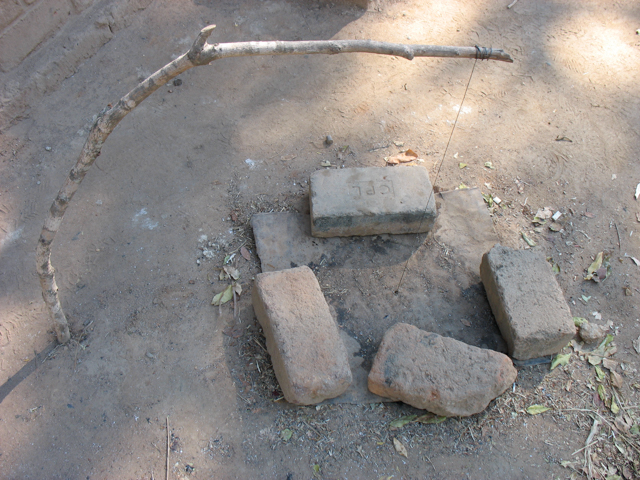Untitled ground-bow song performed by Sekuru Compound Muradzikwa
The ground-bow is unique among Zimbabwean bows, as it uses a hole dug in the earth as a resonating chamber. A sheet of scrap metal covering the hole is held down with bricks. One end of the ground-bow’s single string, which is often made of wire, is tied to the end of a young sapling or tree branch, while the other end of the string is affixed to the underside of the sheet of metal. The resulting tension bends the tree branch into a quarter-arch shape. While Sekuru Chigamba calls the ground-bow kambuya-mbuya, it goes by many other names even within Zimbabwe, including dzikamunhenga, zingaringi, and dibukandinga.
The ground-bow has been documented across much of Sub-Saharan Africa, making it one of the most widely distributed instruments on the African continent. While the instrument has mostly been discussed in equatorial regions, ground-bows extend as far north-west as the Fouta-Djallon region of Guinea, and as far south as the Northern Transvaal. The ground-bow is also widespread in eastern Africa, including many of the islands in the Indian Ocean. Joining its wide distribution across Sub-Saharan Africa, the ground-bow’s reach also crosses the Black Atlantic, extending to Colombia, Cuba, and the Dominican Republic.
Many scholars have suggested that the ground-bow is disappearing, and has already vanished across vast areas where it was formerly played. At the same time, there is evidence that the ground-bow is still actively played in several countries. This includes written accounts, photographs, and online videos from within the past few decades, which depict both children and adults playing ground-bows in places such as Uganda, the Central African Republic, Cameroon, Gabon, Mauritius, Colombia, and Haiti.
Historically, the ground-bow was played mostly by children, often in the context of cattle herding. As Sekuru Chigamba relates:
Kambuya-mbuya was played by people who went with the cattle. Even girls who went went with the cows, herding cattle, they could also play. It is something for young children.
While several factors have contributed to the ground-bow’s marginalization, a long-standing scholarly disregard for children’s music is foremost among them. At the same, the site-specific nature of the ground-bow’s performance has eluded conventional approaches to musical collection and archiving, further contributing to its neglect. With its unique construction, distinctive timbre, complex bent pitches, and widespread associations with children, herding, and the forest, the ground-bow has both a fascinating sound, and a rich social identity. Sekuru’s stories about playing the ground-bow as a young herd boy offer a first-person account of this unique instrument’s historic presence in Zimbabwe.
While Sekuru Chigamba did not continue playing the groundbow into adulthood, his friend Compound Muradzikwa, who was born in 1943, reconstructed a groundbow from his own memories of playing the instrument as a young herdboy. Sekuru Muradzikwa’s songs offer a valuable opportunity to hear this fascinating instrument.


